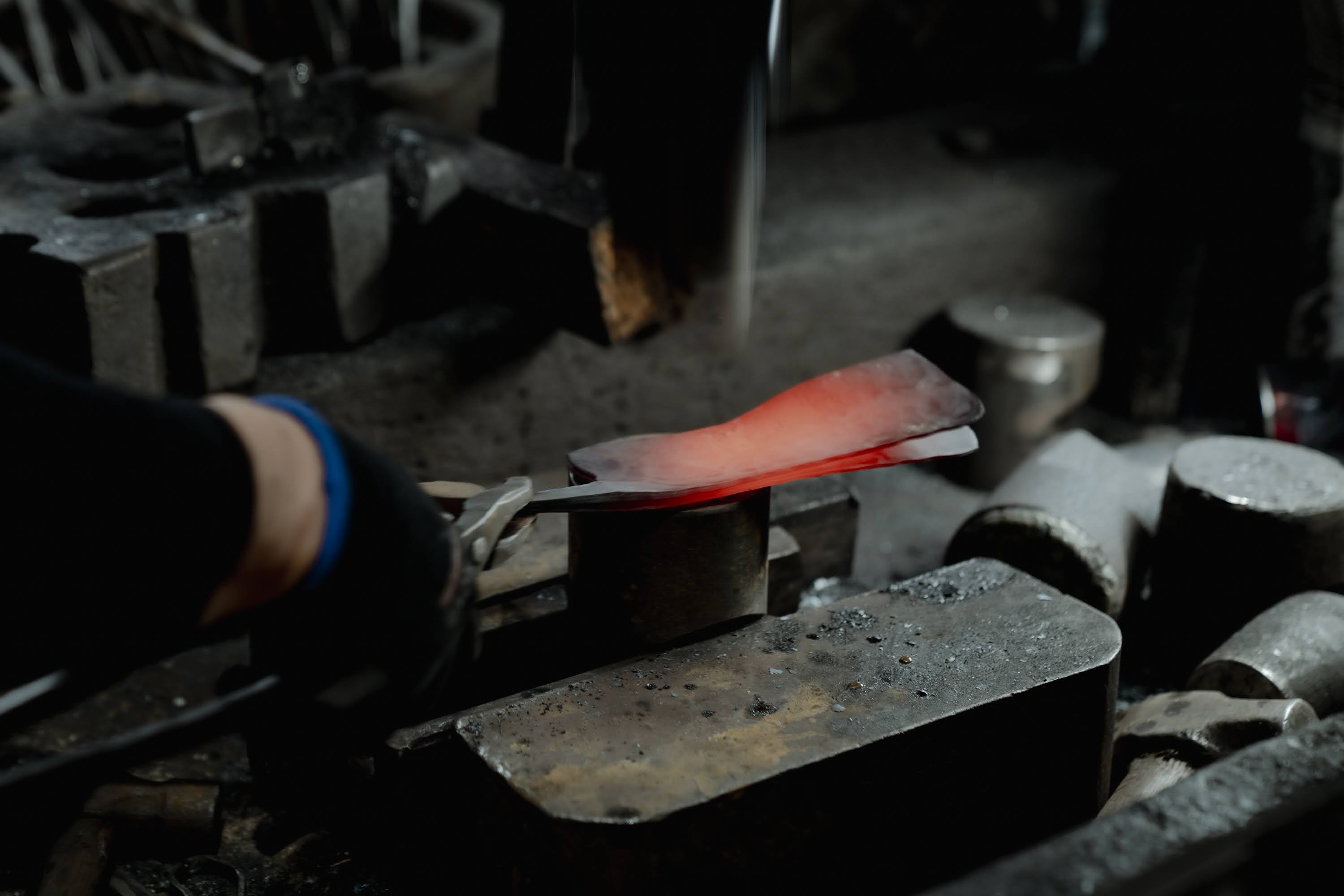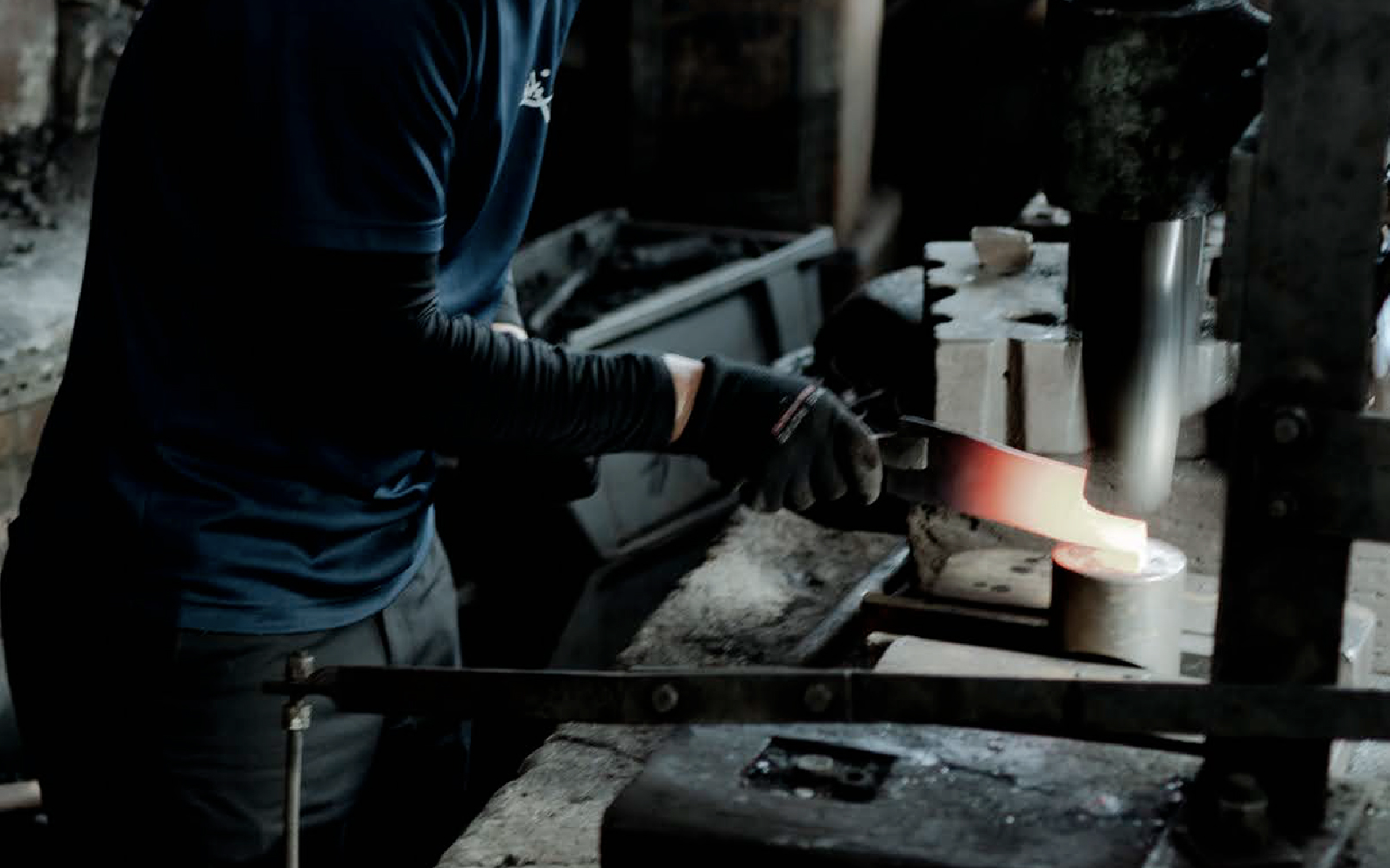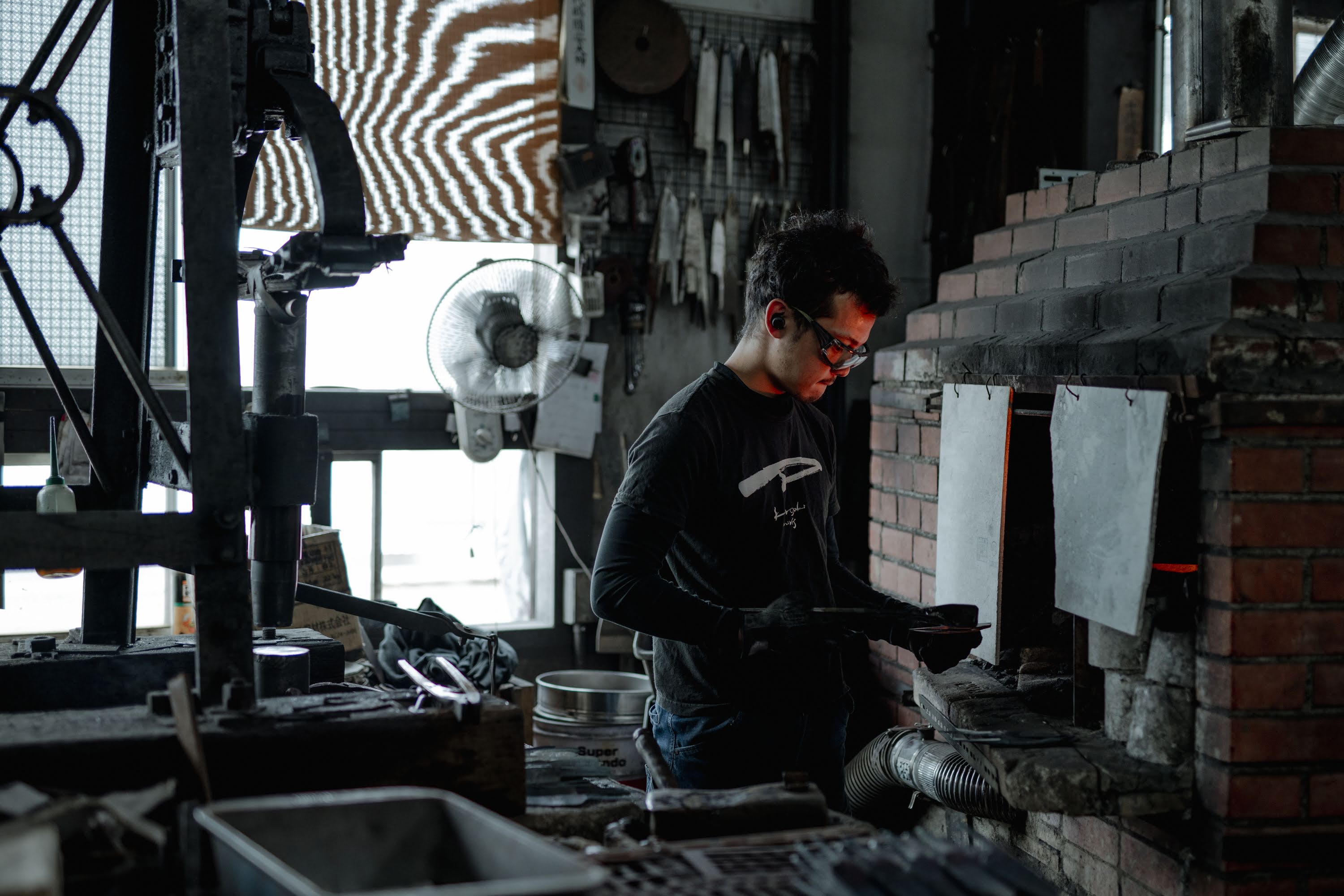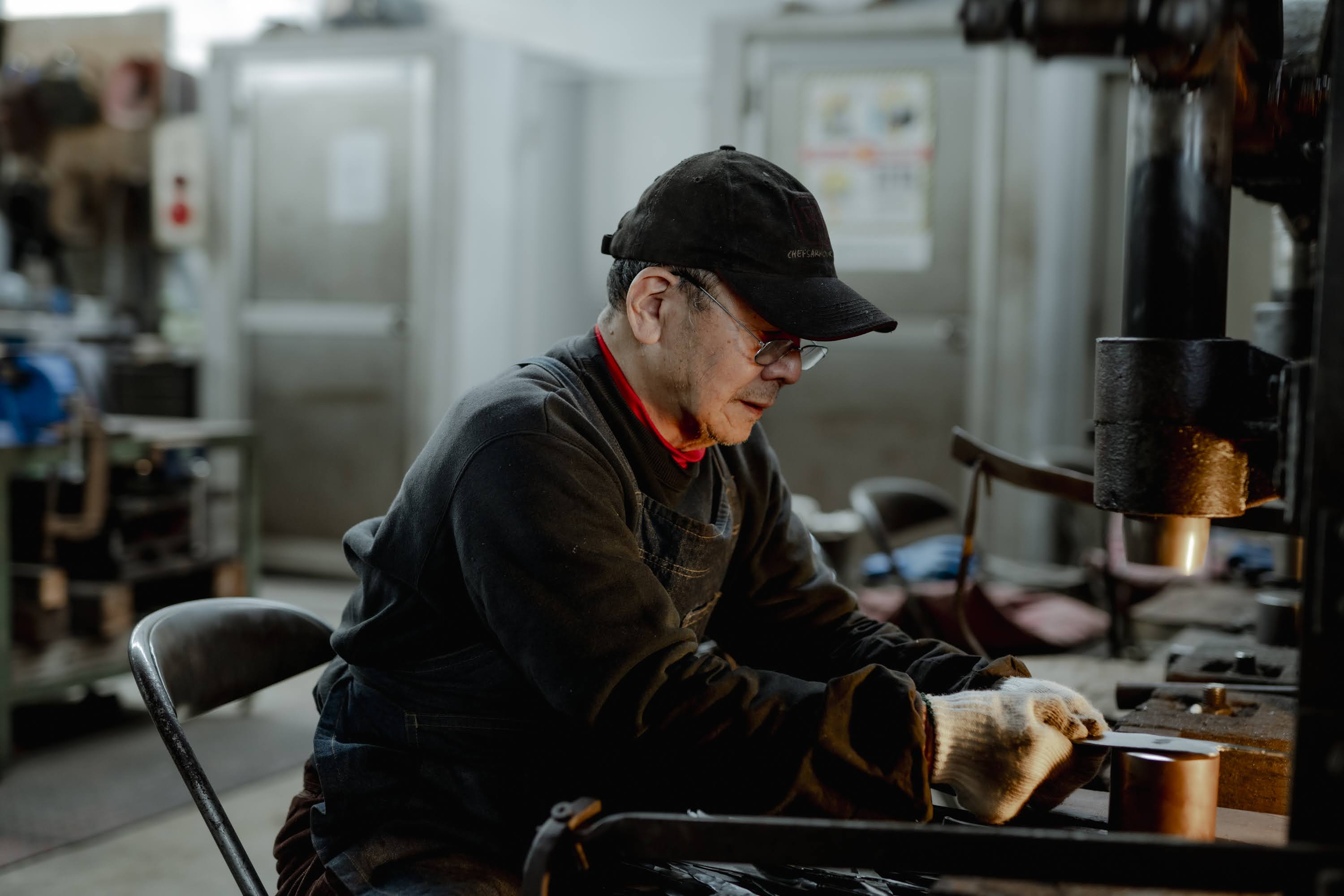Historic Processes
section1
The Story of Echizen Uchihamono that Begins with a Sword
Among the traditional craft techniques that have long been handed down in Echizen City,Echizen hammered blades, represented by kitchen knives and sickles, have a history of more than 700 years, and hammered blade craftsmen continue to forge them every day.
There are 14 major processes for making blades. A block of steel and iron is forged, strengthened, shaped, fired, struck again, fired, cooled, and struck again. Finally, the blade is sharpened and finished. Although some of the processes have been mechanized, the basic production methods have remained unchanged for 700 years.
Among them, the process of Echizen hammered blades has two unique features. The two types of knives are "Nimai-hiroge"and "Mawashi-haganezuke".

The process of "Nimai-hiroge" is to lay two blades on top of each other and strike them from the back and front with a hammer, working quickly so that the two blades are stretched thinly at the same time. The thickness is doubled by overlapping two pieces, and the compression by the hammer increases strength and reduces unevenness of the board, resulting in a high-quality blade.

In the "Mawashi-haganezuke" method, the base iron and steel are forged and welded together, and then the entire blade is smashed into a diamond shape, starting from one corner of the blade edge.We call this "Masaokiho". Compared to the common "flattening method", this method can produce a sickle blade that is thinner, easier to sharpen, and stronger.
The Beginning of Echizen Uchihamono
section2
Sword Master Chiyozuru Kuniyasu goes to Echizen
The story of Echizen hammered blades begins when a swordsmith entered the land of Echizen during the turbulent Nanbokucho period(1336-92), which changed from Kamakura to Muromachi.
In 1337 (Engen 2), "Chiyozuru Kuniyasu", a renowned swordsmith in Kyoto, was looking for a suitable land to manufacture cutlery. After crossing a mountain pass, he entered Echizen Province, which was known for its clean water and abundant iron, both indispensable for the production of cutlery. He loves the area and sets up his workshop in Fuchu. One day, Kuniyasu was working on a "sickle" in addition to sword making. Suddenly, the crescent moon reflected in the pond overlapped with the shape of a sickle, and this is believed to be the origin of the "Echizen sickle".
It is usually rare for a swordsmith to make sickles, and the fact that Kuniyasu left such a legend behind may be evidence that he was well integrated into the Echizen Fuchu community.
Echizen, where the three materials necessary to make blades-water, iron, and fuel-are all available, became a nationally outstanding production center after the visit of a swordsmith named Kuniyasu, and is now recognized worldwide for its techniques.
Katsuyasu Kamo, a traditional craftsman who has been involved in the production of Echizen hammered blades for over 60 years at Takefu Knife Village, describes the Echizen environment.
"Considering the fact that the water is so pure and good quality iron can be extracted, it makes sense. We can also get pine charcoal for fuel for forging. Kuniyasu-san must have entered Echizen with his apprentices and friends, because he could not make swords alone. I think he made the sickle because he was friendly with the people of the town."
The Beginning of Echizen Uchihamono
section2
Make a wish
section3
Komainu (guardian dogs) with a prayer for peace
When one hears the word "sword",one imagines war.
However, Chiyozuru Kuniyasu, as his name implies, was a swordsmith who wished more than anyone else for the peace and tranquility of his country.
Chiyozuru Pond is located in the precincts of Chiyotsuru Shrine in Kyomachi, there is a legend that Kuniyasu made a guardian dog by grinding a whetstone every time he made one of his swords and dunked it into this pond with his wish. Kuniyasu was a swordsmith who believed that a sword should not be used to kill people, but should be a symbol of a samurai.
In fact, many stone-carved komainu (stone guardian dogs) have been found in the shrine's pond, and their expressions are not stern, but rather somewhat charming.
At the time, Kuniyasu swords were popular among Samurai, and the Tarotachi and Jiro-tachi swords used by father and son Naotaka and Takamoto Makara of the Asakura family are well known. The names Taro and Jiro come from the fact that when a samurai of the time carried two swords, the longer one was called "Taro" and the shorter one "Jiro".
The Tarotachi sword was so large that its length was over two meters, and although it was large enough to be carried by several people, it is recorded in the "Akechi Gunki" that Makara Naotaka was able to carry it lightly by himself.
Standing inside the shrine, one seems to feel the back of Kuniyasu, who continued to make swords with the thought, "This is the last sword for war" and delivered the guardian dogs. Mr.Kamo, who continues to forge blades, says that as a producer, he deeply sympathizes with Kuniyasu.
"We craftsmen were often told that Kuniyasu-san used to make wishes on the komainu and submerge them in the pond. He must have had a very gentle personality. A sword is used for fighting, but once you pull it out, it becomes a deadly weapon that has to cut people. Maybe he felt more strongly than others that the world should not be like that."
From the beginning of life
to the end
section4
The sacred object as a talisman of the land and a blade for living
After the Warring States period passed and the samurai era ended, Kuniyasu's sword was also valued as a "lucky charm to open up one's destiny" and a "charm to protect the land", and its very form became a sacred object. Currently, the Otachi(sord) is enshrined at Atsuta Jingu Shrine, and in 1932, it was dedicated to Chiyozuru Shrine.
The Echizen sickle, started by Kuniyasu, was also spread throughout the country by lacquer scrapers in the late Edo period, making the name of Echizen hammered blades famous throughout the world.
And now, Echizen kitchen knives have gained worldwide recognition, with Uchihamono craftsmen traveling to France and other countries far across the sea.

Echizen "cutlery", which has changed its form powerfully and flexibly to meet the needs of the times, is the result of the prayers and thoughts of each craftsman, carefully forged one by one. Although it was the same as that in which samurai wielded swords and trained their bodies and minds, what they protected also changed.

Once again, I recall the komainu that Kuniyasu had submerged in the pond. The komainu are a pair of open-mouthed (a-gyo) and closed-mouthed (un-gyo) "a-un", which means "from the beginning of life to the end of life".
Thinking of the never-ending war and of the people who would spend their lives in Echizen, Chiyozuru Kuniyasu made swords with a prayer for peace in each and every swing. By touching Echizen hammered blades, which have his roots in Echizen, I would like you to think about the world we live in today.
Text / Mikiyo Sato
Synopsis
5Chiyozuru Kuniyasu ⇒ Chiyozuru pond and komainu ⇒ Chiyozuru Shrine ⇒ Makara Jurozaemon "Tarotachi" and Jiro-tachi Chiyozuru Kuniyasu, the founder of Echizen hammered blades, is said to have migrated from Kyoto to Fuchu (now Echizen City) in search of land suitable for blade production around the time of the uprisings in the Nanbokucho period.
It is said that the Echizen sickle originated from a sickle that Kuniyasu made while making swords in Echizen Prefecture, referring to the crescent moon reflected in the Chiyozuru Pond. There is also a legend that Kuniyasu sunk a guardian dog sharpened with a whetstone into Chiyozuru Pond with a wish.
In 1932, the Chiyozuru Shrine was built on the shore of Chiyozuru Pond, where a sword said to have been made by Kuniyasu Chiyozuru I was dedicated as a sacred object to perpetuate Kuniyasu's achievements.
The large daggers handed down at Atsuta Jingu Shrine that are said to have been made by Kuniyasu are famous for remaining today.
From the beginning of life to the end
section4



